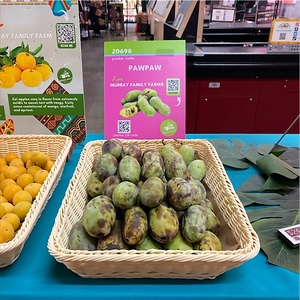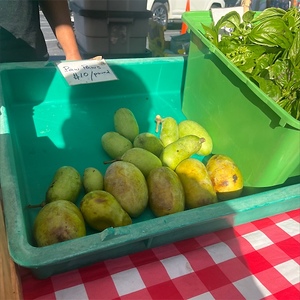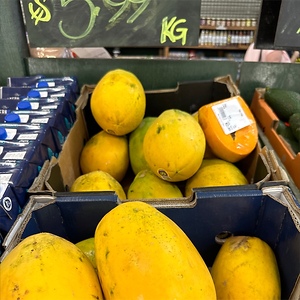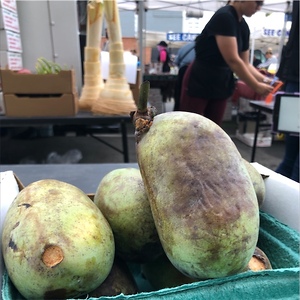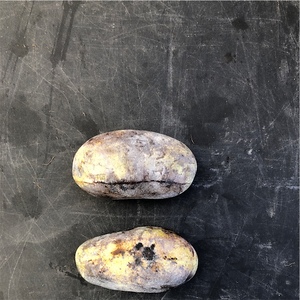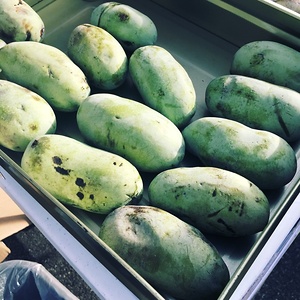

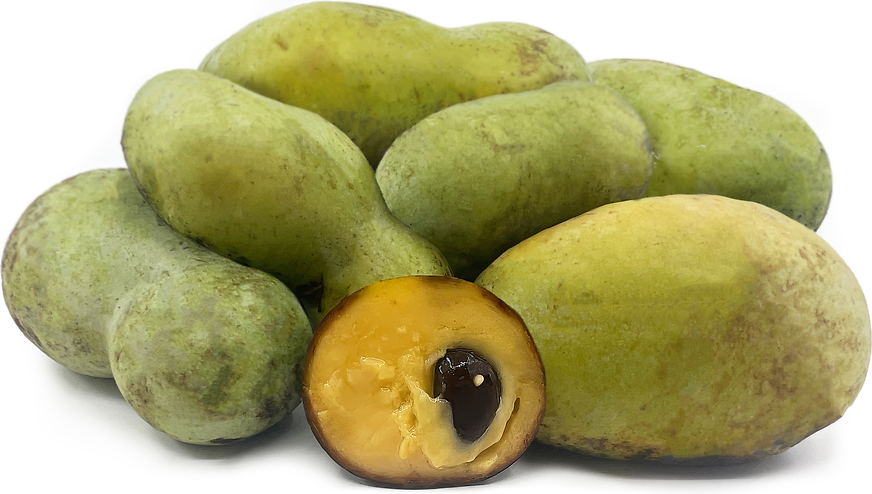
Pawpaw
Estimated Inventory, lb : 0
This item was last sold on : 10/02/24
Description/Taste
Pawpaw fruits are medium to large in size, averaging 5 to 15 centimeters in length and 3 to 8 centimeters in diameter, and have an oval, oblong, to slightly irregular, curved, bulbous appearance. The fruits generally weigh between 150 to 200 grams, sometimes growing as large as 500 grams, and the fruit's skin transitions from green to yellow with maturity. Ripe Pawpaw fruits may also develop large dark brown-black spots, similar to bananas. The skin is thin, semi-smooth, and taut, covered in a powdery, dull bloom, and when ripe, the surface becomes delicate, soft, and easily bruised and punctured. Underneath the skin, the golden yellow-orange flesh is tender, smooth, and custard-like, encasing a few to many glossy, black seeds. Most fruits can have anywhere from 12 to 20 seeds, and the seeds are easy to remove from the flesh. Ripe Pawpaw fruits will have a plump nature with a soft give to the surface when gently squeezed. The flesh releases a pleasant, sweet aroma and has a tropical flavor combined with a musky, yeasty floral aftertaste. The taste of Pawpaw will vary with the variety and the fruit's growing environment, but the fruits have been said to taste like a mixture of coconut, banana, pineapple, mango, and papaya.
Seasons/Availability
Pawpaw fruits are available in the late summer through fall.
Current Facts
Pawpaw, botanically classified as Asimina triloba, is a North American species belonging to the Annonaceae family. The fruits grow on a small, deciduous understory tree reaching 6 to 11 meters in height and are botanically a type of berry that form in hanging clusters from the branches. Pawpaw fruits are the largest edible fruits native to North America and have been present as a wild species in humid, temperate zones for thousands of years. Despite their established and ancient presence in North America as a food source for both animals and humans, Pawpaw fruits have never achieved commercial success due to their short shelf life. Ripe Pawpaw fruits easily bruise, tear, and deteriorate in quality once picked, preventing them from being sold outside their native range. Pawpaw enthusiasts claim that the fruits are the best straight off the tree to savor the fruit's tropical, musky, and fruity flavor. Historically, Pawpaw fruits have been consumed as a foraged food and home garden fruit planted throughout the eastern United States. The fruits are known by many nicknames and name variations, including Paw-Paw, Paw Paw, American Custard apple, Quaker Delight, Hillbilly Mango, Wild Banana, Poor Man's banana, Hipster's banana, Appalachian banana, Ozark banana, Missouri banana, Prairie banana, and several other banana monikers. Pawpaw fruits are traditionally eaten fresh, and the soft, custard-like flesh is utilized in various desserts. Growers are also taking an increased interest in cultivating Pawpaw fruits for various processed juices, purees, alcohols, and other preparations.
Nutritional Value
Pawpaw is a source of vitamin C to strengthen the immune system while reducing inflammation, copper to produce red blood cells, and iron to develop the protein hemoglobin for oxygen transport through the bloodstream. The fruits also provide manganese to assist in metabolizing amino acids, vitamin A to maintain healthy organ functioning, fiber to regulate the digestive tract, magnesium to regulate optimal nerve functioning, and other nutrients, including phosphorus, calcium, and zinc.
Applications
Pawpaw fruits have a fruity, tropical, and musky flavor suited for fresh and cooked preparations. Ripe Pawpaw fruits have a delicate, soft nature and can be torn open by hand to consume the soft, gooey flesh. The skin and seeds are discarded during consumption, and the flesh is enjoyed on its own or strained through a sieve to create a smooth puree. The flesh can also be incorporated into salsa as a creamy addition. Pawpaw puree can be blended into smoothies, shakes, and other drinks, or it can be frozen into ice cream or sorbet. The flesh can also be baked into bread, cakes, and pies, simmered into preserves, or added to custards and puddings. Try Pawpaw as a substitute for bananas in recipes. In addition to Pawpaw fruits being enjoyed in baked preparations and drinks, legend has it that chilled Pawpaw fruits were a favorite dessert of George Washington. Pawpaw fruits pair well with fruits such as oranges, melons, coconut, blueberries, passion fruit, and nectarines, aromatics including onions, cilantro, and garlic, honey, butter, and spices such as cinnamon, ginger, and nutmeg. Whole, nearly ripe Pawpaw fruits can be stored at room temperature in a paper bag until they transform in color and soften. Once ripe, the fruits should be immediately consumed for the best quality and flavor. Ripe Pawpaw fruits picked from the tree ferment relatively quickly after they are harvested and will only keep for a few days in the refrigerator. Pawpaw flesh can also be made into a puree and frozen for extended use. When making a puree, mix in a little lemon juice to prevent the puree from oxidizing and squeeze out all the air before freezing.
Ethnic/Cultural Info
Ohio is home to the annual Pawpaw Festival, a celebration that honors the native North American fruits. The weekend-long event is held in September in Albany near Lake Snowden and features contests, live entertainment, cooking demonstrations, and Pawpaw tastings to savor the in-season fruits. Some notable events include a competition to find the largest Pawpaw and an all-you-can-eat Pawpaw contest to see who can consume the most fruits in a limited period. The Ohio Pawpaw Festival was established in 1999 and was initially held at the Albany Riding Club for the first two years. The festival later moved to its location in Lake Snowden and has been held annually for over 23 years. Pawpaw is Ohio state's only native fruit, and the festival has previously attracted over 9,000 people during the two-day event. Beyond the contests and festivities, the Ohio Pawpaw festival features educational talks to promote the fruits to the public and networking events to connect and inspire local Pawpaw growers. It is important for the volunteers and workers of the event to share the importance of Pawpaw fruits and continue to spread awareness of the native fruit to protect its future. Specialty drinks and foods are also released at the festival to attract foodies. Over 12,000 pounds of Pawpaw pulp is generally used to make craft beers, ice cream, and baked foods for the event.
Geography/History
Pawpaw trees are native to North America and have been growing wild in the eastern United States and Canada since ancient times. The species is related to plants present in the Miocene epoch, approximately 23 to 5.3 million years ago, and megafaunas such as giant sloths, mastodons, and mammoths were thought to have consumed the fruits, spreading the seeds in their excrement. Pawpaw seeds were later dispersed through human intervention after the Ice Age, and Native Americans utilized the fruit and other parts of the tree in culinary and medicinal applications, spreading the species across the eastern United States and north into Canada. The earliest written account of Pawpaw fruits was in the report of a Portuguese officer in the 1541 expedition with Hernando de Soto throughout the southern United States. The officer noted that Native Americans were cultivating the crop near the Mississippi River and were consuming the fruits as a food source. This expedition was the first time the species was referred to as Pawpaw. It is said that members of the expedition team said the fruits resembled papaya, and during this period, Pawpaw was once a name for papaya. Over time, the name stuck, and the North American fruits became known as Pawpaw. In the late 18th and early 19th centuries, Thomas Jefferson cultivated Pawpaw in his estate gardens at Monticello in Virginia, and he sent seeds to friends in Europe to help expand the species. Lewis and Clark also consumed Pawpaw fruits on their expedition in the early 19th century, sometimes surviving almost entirely off them for days. Pawpaw fruits have been extensively documented throughout American history and have remained intertwined into the lifeblood of the culture and folklore of the eastern United States. In fact, the species has been named Missouri's official state fruit, and there are several towns named Pawpaw in the plant's native region. In 1990, Kentucky State University established the world's only full-time Pawpaw research program to study, preserve, and advance the fruits. The program has created several new varieties of Pawpaw and is the site of the Pawpaw National Clonal Germplasm Repository. Today Pawpaw fruits are the most widespread species of the eight North American species a part of the Asimina genus. The species is indigenous to at least 26 states and is found in regions from New York to northern Florida and east to Texas and the Midwest. Pawpaw trees are also grown in Ontario, Canada, and have been planted on a small scale in the Pacific Northwest. The trees thrive in humid, nutrient-dense forests and are often found in woodlands, floodplains, and wooded slopes. When in season, Pawpaw fruits are foraged from wild trees, cultivated by enthusiasts, or picked from home garden trees for sale through specialty distributors, direct from growers, or farmer's markets.
Recipe Ideas
Recipes that include Pawpaw. One



